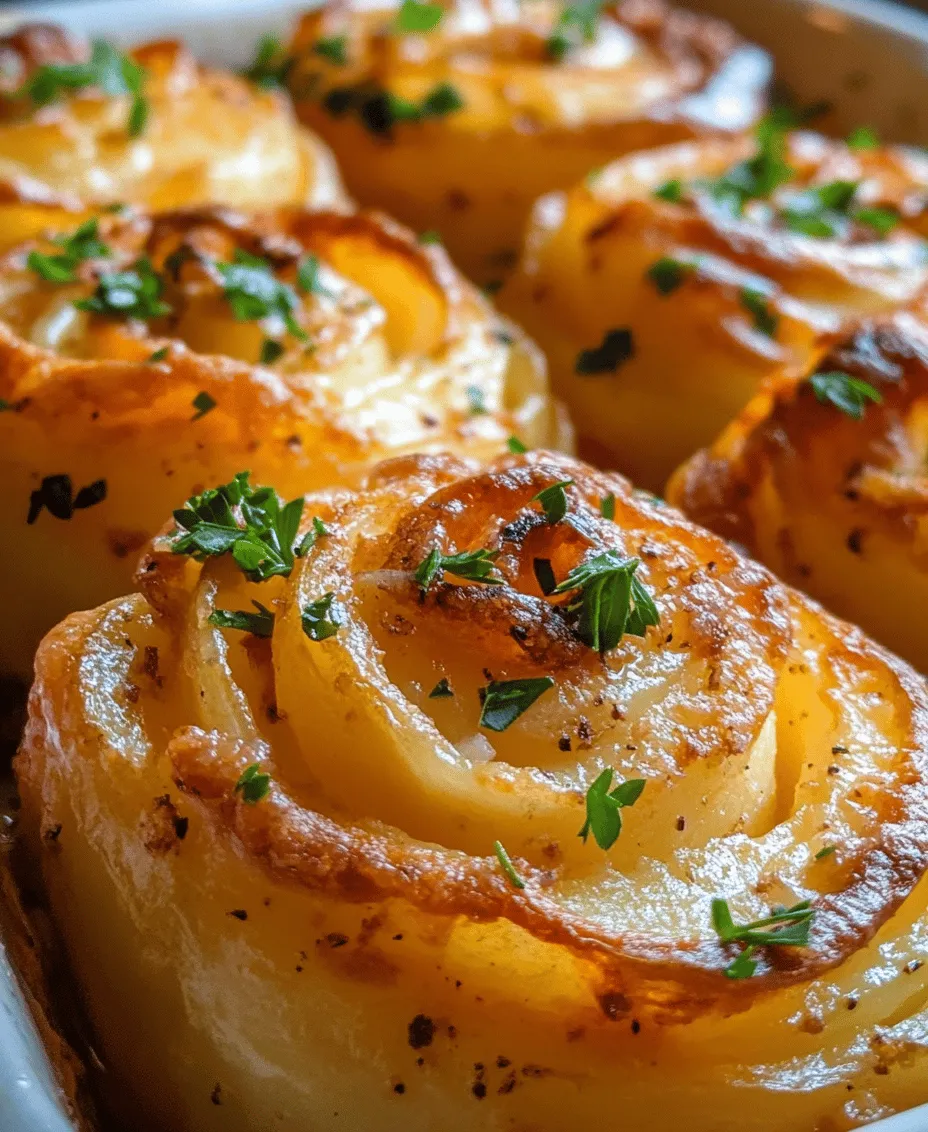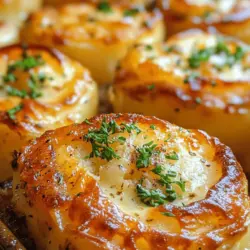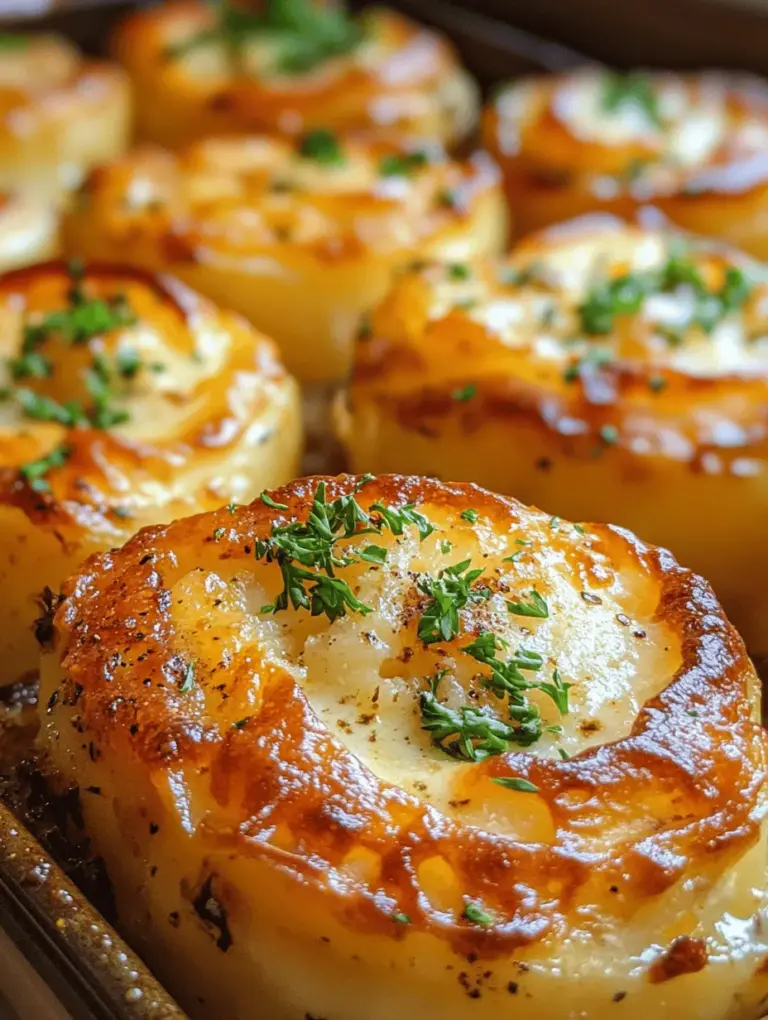Introduction
When it comes to gourmet side dishes that elevate any meal, few can rival the elegance and charm of Duchess Potatoes. This classic French dish, recognized for its beautiful piped shape and rich, creamy texture, is a delightful addition to both everyday dinners and festive occasions. Its unique preparation transforms simple potatoes into a decadent treat, making it a favorite on holiday tables and upscale dining experiences alike.
Duchess Potatoes are more than just a side dish; they embody a culinary tradition that blends simplicity with sophistication. The dish showcases the versatility of potatoes, turning them into a luxurious accompaniment that pairs perfectly with a variety of main courses, from roasted meats to grilled fish. Whether you’re planning a holiday feast or simply looking to impress at a dinner party, Duchess Potatoes provide that wow factor without requiring an extensive list of ingredients or complicated techniques.
In this article, you will find a comprehensive recipe and detailed step-by-step guide to creating Classic Duchess Potatoes. We will delve into the history of this delightful dish, explore the key ingredients that contribute to its signature flavor, and provide clear instructions for preparing it to perfection. By the end, you’ll be equipped with the knowledge to impress your guests and indulge your palate with this timeless side dish.
Understanding Duchess Potatoes
Definition and Origin of Duchess Potatoes
Duchess Potatoes, or “Pommes Duchesse” in French, are a type of mashed potato dish that is piped into decorative shapes and baked until golden brown. The name is believed to be inspired by the French nobility, specifically the Duchesses, who were known for their elegance and taste in fine cuisine. This dish first appeared in culinary literature in the 19th century, but its roots can be traced back even further, as chefs began experimenting with the art of shaping and cooking potatoes in more refined ways.
Historical Context and Evolution of the Recipe
The evolution of Duchess Potatoes reflects broader trends in French cuisine, particularly the movement towards artful presentation and the elevation of humble ingredients. Initially, potatoes were considered a staple food, often prepared in a straightforward manner. However, as culinary techniques advanced, chefs began to recognize the potential of potatoes to be transformed into something extraordinary. Duchess Potatoes emerged as a way to showcase this versatility, combining simple ingredients with sophisticated techniques.
Over the years, the recipe has seen variations, with some chefs adding ingredients like truffle oil or different cheeses to enhance the flavor. However, the classic version remains a beloved staple, celebrated for its creamy interior and crispy exterior. Today, Duchess Potatoes continue to grace tables around the world, from elegant dinner parties to holiday feasts, serving as a testament to their enduring appeal.
The Role of Duchess Potatoes in Gourmet Cooking and Festive Meals
In gourmet cooking, presentation is key, and Duchess Potatoes shine in this aspect. Their elegant piped form makes them visually stunning, allowing them to stand out on any plate. This visual appeal, combined with their rich flavor and creamy texture, makes them a perfect companion to a variety of dishes, including roast beef, glazed ham, or even a simple baked chicken. They elevate any meal from ordinary to extraordinary.
During festive seasons, Duchess Potatoes become a staple, often featured at Thanksgiving, Christmas, and other celebrations. Their ability to complement rich main courses while offering a lightness in texture makes them an ideal side dish for holiday feasts. Moreover, they can be made ahead of time and simply popped in the oven just before serving, making them a practical choice for busy hosts.
Key Ingredients
Creating the perfect Duchess Potatoes requires a selection of high-quality ingredients that work together to achieve the signature flavor and texture. Below is a detailed description of each ingredient used in the recipe.
Yukon Gold Potatoes: Why They Are Preferred
The foundation of any great Duchess Potato recipe is, of course, the potatoes themselves. Yukon Gold potatoes are the preferred choice due to their creamy texture and naturally buttery flavor. These medium-starch potatoes mash beautifully, resulting in a smooth and velvety mixture that holds its shape when piped. Unlike starchy potatoes, such as Russets, which can become too dry or mealy, Yukon Golds provide the perfect balance of moisture and creaminess.
Unsalted Butter: Importance in Flavor and Texture
Next on the ingredient list is unsalted butter, which plays a critical role in both flavor and texture. Using unsalted butter allows you to control the saltiness of the dish, ensuring that the delicate flavors shine through. Butter adds a richness that enhances the overall creaminess of the potatoes, contributing to that luxurious mouthfeel that is characteristic of Duchess Potatoes.
Heavy Cream: How It Contributes to Creaminess
Heavy cream is another key ingredient that elevates the dish to new heights. It adds a luscious creaminess that makes the mashed potatoes rich and indulgent. The fat content in heavy cream also helps achieve the desired texture, creating a smooth, velvety consistency that is perfect for piping. For those looking for a lighter version, half-and-half can be used, but the results may not be quite as decadent.
Garlic and Onion Powders: Enhancing the Flavor Profile
To enhance the flavor profile of the Duchess Potatoes, garlic and onion powders are included. These ingredients add depth and complexity without overwhelming the dish. The gentle sweetness of onion powder and the savory notes of garlic powder create a well-rounded flavor that complements the buttery potatoes beautifully. Feel free to adjust the amounts to suit your personal taste preferences.
Ground Nutmeg: Its Subtle Yet Significant Role
A pinch of ground nutmeg rounds out the flavor of Duchess Potatoes, providing a subtle warmth that enhances the overall taste. Nutmeg is a classic seasoning used in many creamy dishes, and its warm, slightly sweet flavor pairs exceptionally well with potatoes. It’s essential to use nutmeg sparingly, as a little goes a long way, ensuring that the nutmeg does not overpower the other flavors.
Eggs: Function in Binding and Texture
Eggs are a crucial component in this recipe, serving as a binding agent that helps hold the potato mixture together. They also contribute to the structure and texture of the Duchess Potatoes, ensuring that they maintain their shape when piped and baked. The addition of eggs gives the potatoes a slightly crisp exterior while keeping the inside creamy and rich.
Parmesan Cheese: Adding Depth of Flavor
To elevate the flavor even further, freshly grated Parmesan cheese is mixed into the potato mixture. Parmesan adds a savory, nutty flavor that enhances the richness of the dish. It also contributes to the golden-brown crust that forms during baking, creating a delightful contrast in texture. For the best results, opt for high-quality Parmesan cheese, as it will significantly impact the overall flavor.
Fresh Parsley: The Finishing Touch for Presentation
Finally, fresh parsley is used as a garnish to add a pop of color and freshness to the finished dish. Chopped parsley not only enhances the visual appeal but also provides a refreshing contrast to the rich flavors of the Duchess Potatoes. Additionally, it can offer a hint of herbal notes that brighten the overall taste.
Importance of Ingredient Quality and Sourcing Tips
To achieve the best results when making Classic Duchess Potatoes, sourcing high-quality ingredients is paramount. When selecting Yukon Gold potatoes, look for firm, unblemished potatoes that are free from sprouts or green spots. For the butter and cream, choose organic or grass-fed options if possible, as they tend to have richer flavors. Freshly grated Parmesan cheese will always outperform pre-grated varieties, as it retains more flavor and has a better texture for melting. Lastly, opt for fresh herbs over dried, as they provide a more vibrant taste and appearance.
Step-by-Step Instructions for Classic Duchess Potatoes
Preparation of the Potatoes
Before diving into the recipe, it’s essential to prepare your ingredients correctly. Start by selecting your Yukon Gold potatoes, ensuring they are clean and free from blemishes.
Importance of Cubing and Peeling Yukon Gold Potatoes
Begin by peeling the potatoes using a vegetable peeler. After peeling, cut the potatoes into evenly-sized cubes, about 1 to 2 inches in size. This step is crucial as it ensures the potatoes cook evenly, allowing for a smooth mash without lumps. The cubed potatoes will cook faster and more uniformly, making the mashing process easier.
Detailed Cooking Instructions for Achieving the Right Texture
Place the cubed potatoes in a large pot and cover them with cold water. Adding the potatoes to cold water helps them cook evenly from the inside out. Generously season the water with salt, which will enhance the flavor of the potatoes as they cook. Bring the pot to a boil over medium-high heat, then reduce the heat to a gentle simmer. Allow the potatoes to cook for approximately 15 to 20 minutes, or until they are fork-tender.
Once the potatoes are cooked, drain them thoroughly in a colander and let them sit for a minute to allow excess moisture to evaporate. This step is vital for achieving the perfect texture, as too much moisture can lead to watery Duchess Potatoes.
Next, transfer the drained potatoes back to the pot over low heat. This will help evaporate any remaining moisture, ensuring your mashed potatoes are rich and creamy. Using a potato masher or ricer, mash the potatoes until they are smooth and free of lumps.
As you mash, gradually incorporate the unsalted butter, allowing it to melt and blend into the potatoes. Follow this by adding the heavy cream, mixing until the mixture is creamy and well combined. At this stage, you can also incorporate the garlic powder, onion powder, ground nutmeg, and freshly grated Parmesan cheese, stirring until everything is evenly distributed.
Finally, add the eggs one at a time, mixing until they are fully incorporated. The mixture should be smooth, rich, and easily piped. If desired, taste the mixture and adjust the seasoning with salt and pepper as needed.
With the potatoes prepared, you are now ready to pipe and bake them to create the exquisite Duchess Potatoes that will impress your family and friends.
Stay tuned for Part 2 of this article, where we will continue with the piping techniques, baking instructions, and tips for achieving the perfect presentation of Classic Duchess Potatoes Delight.

Mashing and Mixing
The heart of Classic Duchess Potatoes lies in the perfect mashing and mixing technique. Begin by using a potato ricer or a food mill to ensure a silky smooth texture. If you don’t have these tools, a traditional masher will suffice, but be cautious—over-mashing can lead to a gluey consistency. Once your potatoes are riced, allow them to cool slightly before adding the butter. This step is crucial, as hot potatoes can melt the butter too quickly, preventing it from emulsifying properly.
When you add the butter, use a wooden spoon or spatula to fold it into the potatoes until fully incorporated. Next, gently mix in the egg yolks one at a time. It’s essential to incorporate them thoroughly to achieve a rich and creamy texture. The warm potatoes will help cook the yolks slightly, adding a beautiful richness to the dish. Always remember: the key to achieving that luxurious consistency is to mix just enough until everything is combined—don’t overwork the mixture.
Importance of Temperature When Incorporating Eggs
The temperature of your ingredients plays a vital role in achieving the desired texture of Duchess Potatoes. Incorporating room temperature eggs into your potato mixture allows for better emulsification, resulting in a creamier and more cohesive final product. If your eggs are too cold, they can cause the butter to solidify, leading to an uneven mixture. To reach the perfect temperature, let your eggs sit out for about 30 minutes before use. This simple step can make a noticeable difference in the creaminess of your Duchess Potatoes.
Piping Techniques
Once your potato mixture is ready, it’s time to pipe it into beautiful shapes. For this, you will need a piping bag fitted with a star tip. This tool allows for precision and creativity in presentation. Start by filling the piping bag with the potato mixture, ensuring there are no air bubbles trapped inside. To create a lovely rosette, hold the bag vertically above your baking tray and squeeze gently while twisting the bag to form a star shape. Release pressure before lifting the bag away to avoid any unsightly peaks.
Be creative! Duchess Potatoes can be piped into various designs, such as spirals, swirls, or even free-form shapes. These artistic touches not only enhance the visual appeal but also make the dish feel more gourmet and inviting.
Baking Process
Baking your Duchess Potatoes correctly is essential for achieving that desired golden top. Preheat your oven to 400°F (200°C) to ensure an even baking environment. Arrange your piped potato shapes on a parchment-lined baking sheet, allowing some space between them for even cooking. Bake for about 20-25 minutes or until the tops are golden brown and crispy.
Keep an eye on the potatoes during the last few minutes of baking; this is when they can quickly go from perfectly golden to overdone. An excellent indicator of doneness is a firm crust that holds its shape and a golden hue on top. You might also want to turn on the broiler for the last couple of minutes to achieve an extra crispy finish, but ensure you watch them carefully to prevent burning.
Serving Suggestions
Classic Duchess Potatoes are incredibly versatile and pair beautifully with a variety of main dishes. For a traditional meal, serve them alongside roasted meats like beef, chicken, or lamb. The creamy texture of the potatoes complements the savory flavors of roasted meats. Alternatively, they make a stunning side for vegetarian options such as grilled vegetables or stuffed bell peppers.
When plating, consider elevating the dish visually. A sprinkle of fresh herbs like chives or parsley can add a pop of color and flavor. You can also drizzle a light sauce or gravy over the potatoes to enhance their appeal. In terms of portion sizes, a serving of Duchess Potatoes typically ranges from 1/2 to 1 cup, depending on the meal.
Variations and Customizations
While the classic recipe for Duchess Potatoes is delightful on its own, there are numerous ways to customize this dish to suit your taste preferences. For a flavor boost, consider adding fresh herbs such as thyme, rosemary, or chives directly into the potato mixture. You can also mix in different cheeses like Gruyère, cheddar, or even goat cheese for a unique twist.
Exploring alternative cooking methods can also be fun. Sweet potatoes can be used in place of regular potatoes for a sweeter flavor and vibrant color. The same piping technique applies, offering a delightful change for those looking for something different.
For dietary restrictions, you can adapt Duchess Potatoes to be gluten-free by ensuring all ingredients are certified gluten-free. If you’re looking for a vegan option, substitute the butter with plant-based alternatives and use aquafaba (the liquid from canned chickpeas) in place of egg yolks. These variations allow everyone to enjoy this elegant dish without compromising on flavor.
The Cultural Significance of Duchess Potatoes
Duchess Potatoes have a rich history and cultural significance, often gracing festive tables across the globe. In French cuisine, they are considered a classic and are frequently served during celebrations and family gatherings. Their elegant presentation makes them a popular choice for weddings, holiday feasts, and special occasions.
Many families have personal anecdotes tied to this dish, often recalling the first time they tasted Duchess Potatoes at a grand dinner or holiday meal. These stories highlight the connection between food and memories, reminding us of the joy that comes from sharing a beautifully prepared dish with loved ones.
Conclusion
Classic Duchess Potatoes are a delightful addition to any meal, showcasing the joy of creating a gourmet experience with a simple recipe. Their creamy texture, elegant presentation, and versatility make them a perfect side dish for various occasions, from casual dinners to grand celebrations.
As you embark on making this dish at home, remember that the joy of cooking lies not only in the final product but also in the process. Enjoy the journey of mashing, mixing, and piping, and take pride in serving a dish that is sure to impress. Whether for a festive gathering or a cozy family dinner, Classic Duchess Potatoes will undoubtedly elevate your culinary repertoire and create lasting memories at your table.

